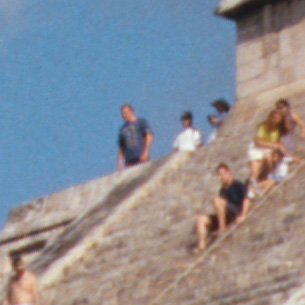Kodak RFS 3600: Film Scanner With a Split Personality
Kodak probably has more sheer knowledge of imaging and imaging science, and more nifty technologies squirreled away in the back rooms, than just about any other company. But I and other Kodak watchers often find ourselves shaking our heads over the process by which the Great Yellow Father translates that knowledge and technology into products.
Over the years, Kodak has come up with rather more than its share of clockwork oranges, electric bananas, and other weirdnesses — remember that the original plan for PhotoCD was that it would let people look at still images on their TVs. Viewed in the context of the Photo CD Player or the similarly ill-fated Disc Camera, the Kodak Professional RFS 3600 Film Scanner isn’t at all bad, but it gives the impression of being a work in progress that’s still trying to figure out what it wants to be when it grows up.

The schizoid appearance it presents to the world is mainly due to the fact that the scanner ships with two very different drivers. The Kodak RFS3600 Film Scanner V1.20 acquire plug-in seems to be aimed at fast automatic scanning of unmounted strip film. The other driver, a custom version of Lasersoft Imaging’s SilverFast Ai, is an extremely full-featured scanning plug-in. Like the Kodak plug-in, it supports batch scanning, but that’s not really its forte; its much richer feature set makes for a concomitantly much steeper learning curve. In truth, the main reason Kodak seems to have for bundling SilverFast is as a stopgap solution to the many acknowledged bugs in its own acquire module.
Despite the Kodak software’s quirks and the somewhat daunting user interface of SilverFast Ai, the RFS 3600 is a capable scanner that can produce excellent results — but so can many of its competitors. What makes the RFS 3600 stand out from the pack? Why would you choose it rather than competing scanners such as the Nikon Super CoolScan 4000 ED, the Microtek ArtixScan 4000t, or the Polaroid SprintScan 4000, to name but a few?
Did We Mention Free Film?
At $999, the RFS 3600 is priced comparably to the Microtek ArtixScan 4000t, and is considerably less expensive than the competing offerings from Nikon and Polaroid. To sweeten the deal, if you buy the scanner before January 31, 2002, you can get 100 free rolls of Kodak Ektachrome, Portra, T-Max, or Tri-X 35mm film (you can mix and match in blocks of 20 rolls).
The RFS3600 offers both USB and SCSI II interfaces. Scanning is much faster through the SCSI II interface than through USB. When connected via SCSI, the scanner itself becomes the bottleneck, since the interface can transfer the data as fast as the scanner can produce it. USB’s slower transfer rate limits the speed with which you can scan. Scanning a full frame at maximum resolution takes a little shy of three minutes through SCSI, as opposed to about a quarter of an hour via USB.
At 3600 pixels per inch (ppi), the RFS has a lower resolution than the competing scanners, which all capture 4000 ppi. (Of course, Kodak used to claim that a 2048-x-3072-pixel Photo CD image would capture all the detail from 35mm film.) In practice, thanks in part to excellent optics, the difference between the RFS 3600 resolution and the 4000 ppi of competitive products is quite small: 4000 ppi will produce a larger file, but we suspect that the vast majority of images scanned at that resolution won’t reveal greater detail (see Figure 1).


Figure 1: Figure 1a (top) shows a detail from a 3600-pixel-per-inch scan from the Kodak RFS 3600. Figure 1b (bottom} shows the same detail from a 4000-pixel-per-inch scan from the Nikon Super CoolScan 4000 ED.
Kodak claims a dynamic range of 3.6 for the RFS 3600. This seems distinctly conservative — we were able to obtain very satisfactory shadow detail on slides, and on color negative scans the Kodak scanner actually produced less noise in the highlights than some competing scanners with higher dynamic range specs (see Figure 2).


Figure 2: Figure 2a shows shadow detail from a slide scanned at default settings on the Kodak RFS 3600. Figure 2b shows the same area scanned at default settings on the Nikon Super CoolScan 4000 ED. Despite the narrower claimed dynamic range of the Kodak scanner, it produced more open, if slighly noisier shadows than the Nikon.
Note: To see images from the Kodak FRS3 3600 as uncompressed TIFF files: Click here for a scan of a film negative(1.84 MB); click here here for a scan of a slide (1.84 MB).


